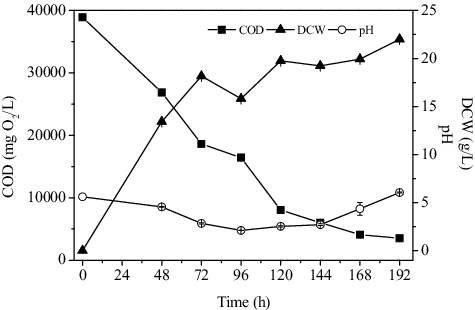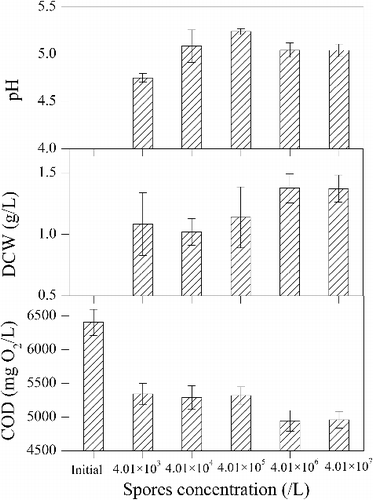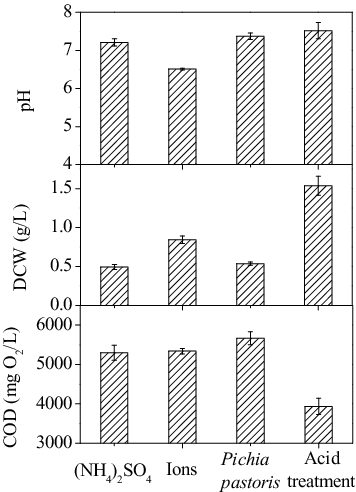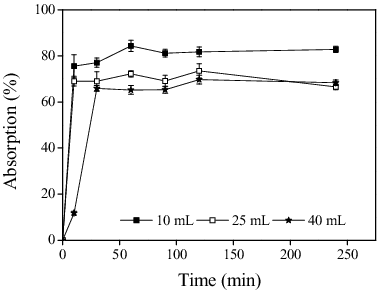 ?Mathematical formulae have been encoded as MathML and are displayed in this HTML version using MathJax in order to improve their display. Uncheck the box to turn MathJax off. This feature requires Javascript. Click on a formula to zoom.
?Mathematical formulae have been encoded as MathML and are displayed in this HTML version using MathJax in order to improve their display. Uncheck the box to turn MathJax off. This feature requires Javascript. Click on a formula to zoom.ABSTRACT
Using biological processes to treat soybean wastewater has great potential, because it generates biomass and reduces sludge production. The formation of Aspergillus niger pellets during cultivation in wastewater has the additional benefit that such pellets are easy to harvest. In the first wastewater treatment step, A. niger pelletization decreased the chemical oxygen demand (COD) by 80.35%. In the second step, A. niger, when combined with added nutrients and cultivated in the presence of Pichia pastoris, did not decrease the COD. Aspergillus niger did not degrade some carbon compounds according to total carbon, organic carbon, and inorganic carbon analysis. The COD decreased from 3.26 × 104 mg O2/L to 616.67 mg O2/L (a 98.11% COD reduction) after activated carbon absorption, which indicates that this approach is efficient. In summary, this study proposes a combined method to treat high-COD-value soybean wastewater.
Introduction
Soybean foods, such as tofu, soy yoghurt, natto, soy sauce, tempeh, soy cheese, sufu, soymilk, soybean sprouts, and soy protein, are widely eaten in Asia. Soybean foods are also eaten in other countries not only because of their delicious taste, but also because of their health benefits [Citation1]. Therefore, it is reasonable to assume that an increasing amount of soybeans will be processed to meet the demand for various soy food products. In 2014, the top 50 soybean food companies processed 9.6 × 108 kg soybeans. Generally, 7–10 m3 of wastewater is generated when 1000 kg soybean is processed, and the resulting chemical oxygen demand (COD) is greater than 20,000 mg O2/L. Therefore, the amount of wastewater produced increases with increasing soybean food production. In China, daily soybean wastewater production was over 60,000 m3 in 2012. Soybean wastewater treatment is important for a sustainable society because it enables water recycling. Traditionally, wastewater treatment was conducted using a combination of an up-flow, anaerobic sludge blanket (UASB), an anaerobic baffled reactor (ABR), and an anoxic–oxic (A/O) treatment. A UASB reduces the COD at a high loading rate (up to 4.0 × 107 mg O2/(m3·d)), and it is the major treatment method that is used to generate methane from microbes. A UASB unit requires a long start-up time [Citation2], and a long time to return to working conditions when the unit is out of balance because of the low growth rate of methanogens and their sensitivity to chemicals [Citation3]. An ABR is another anaerobic method that is used to treat wastewater with a relatively low COD [Citation4]. A/O treatment, such as a sequencing batch reactor, is the final method, and it is performed using activated sludge [Citation5] and a biological-aerated filter [Citation6]. Traditionally, more than 60% of the organic matter in wastewater is transferred into sludge in a wastewater treatment plant [Citation7]. Therefore, a large amount of sludge is generated every year, and this has adverse effects on the environment. To reduce the amount of sludge generated and to recycle organic matter in the wastewater, many species of microbes have been cultivated in wastewater to generate biomass or value-added products. Different species of microbes have different characteristics. For example, bacteria have a high growth rate, which potentially results in greater biomass production and greater COD removal [Citation8--Citation10]. Microalgae are considered to supply a sustainable energy source at the time of COD removal [Citation11]. Yeast, such as Candida utilis, has coagulation properties, which is a benefit of biomass harvesting [Citation12]. Aspergillus niger (A. niger) pellets provide additional benefits because they are easier to harvest than microalgae [Citation13], easier to cultivate, and their metabolites are generally regarded as safe (GRAS) by the United States Food and Drug Administration [Citation14]. Aspergillus niger also produces many kinds of enzymes that have the potential to degrade polysaccharides [Citation15].
This study developed an efficient approach to treat soybean wastewater using A. niger, and the COD was reduced efficiently via an activated carbon absorption process.
Material and methods
Soybean wastewater was obtained from Shanghai Tramy Green Food Co., Ltd. Aspergillus niger was obtained from the Key Laboratory of Industrial Fermentation Microbiology (Tianjin University of Science & Technology). Chemicals were purchased from Sinopharm Chemical Reagent Co., Ltd. (Shanghai, China).
Aspergillus niger spore preparation
Aspergillus niger spores were harvested in deionized water from potato dextrose agar plates after 7 d of cultivation at 30 °C from an A. niger storage solution (25% glycerol). Spores of A. niger were counted using a microscope (H100, Phenix Optical Co., Ltd. Shangrao, China). The number of A. niger spores was calculated according to the following equation:(1)
(1) M: A. niger spores, as determined by counting five chambers of a hemocytometer.
Aspergillus niger cultivation in soybean wastewater
Aspergillus niger pelletization was conducted in 250-mL flasks containing 100 mL of soybean wastewater, which was adjusted to pH 5.5 after sterilization at 121 °C for 15 min. These flasks containing soybean wastewater and 6.5 × 103 spores/L of A. niger were cultivated at 27 °C with shaking at 160 rpm.
Aspergillus niger cultivation in wastewater supernatant
To reduce the COD, A. niger (4.01 × 106 spores/L) was inoculated into a 250-mL flask containing 100 mL of wastewater supernatant and ammonia sulphate (1.00 g/L) and ions (4.78 g/L NaNO3, 0.67 g/L K2HPO4.3H2O, 0.05 g/L CaCO3, and 3.34 g/L MgSO4.7H2O). And A. niger cultivation was carried for 144 h of cultivation at 27 °C.
Acid treatment was conducted by mixing with concentrated sulphate acid and the soybean wastewater supernatant to yield a final sulphate acid concentration of 4%. This mixture was heated at 121 °C for 60 min in an autoclave, and the pH was adjusted to 5.5 by adding sodium hydroxide.
Soybean wastewater supernatant treatment using activated carbon
After the acid treatment and A. niger cultivation, different volumes of the soybean wastewater supernatant (10, 25, and 40 mL) were mixed with 4 g of activated carbon. This system was stirred at 160 rpm at 27 °C, and the COD was analysed at different mixing times.
Analysis of COD, dry cell weight (DCW), total sugar, total carbon (TC), total organic carbon (TOC), and inorganic carbon (IC)
Aspergillus niger pellets in a 250-mL flask were harvested by sieving and washed with deionized water. The A. niger pellets were dried in an oven at 65 °C until reaching a constant weight to obtain the DCW. The soybean wastewater COD was determined using COD vials (20–1500 mg O2/L) from Hach (Loveland, CO, USA). A spectrophotometer (DR6000, Hach) was used to read the COD value after 2 h of digestion, followed by a cool down in a digital reactor block (DRB200, Hach). The total sugar concentration was determined using the anthrone-sulphuric acid method [Citation16]. TC, TOC, and IC were determined by a TOC analyzer (TOC/TN, Shimadzu, Kyoto, Japan). Ions in the wastewater were analysed by the PONY Testing International Group (Shanghai, China).
Data statistics
All experiments were performed three times, and the data were analysed using Microsoft Excel (Seattle, WA, USA) to obtain standard deviations.
Results and discussion
Time course of soybean wastewater treatment using A. niger pelletization
According to previous results, the optimal A. niger spore concentration was 6.5 × 103 spores/L for soybean wastewater treatment by pelletization [Citation17]. The COD decreased sharply from 3.89 × 104 mg O2/L to 8.20 × 103 mg O2/L after 120 h of cultivation, and further decreased to 6406 mg O2/L at 144 h, which represents a 80.35% reduction in the COD (). The biomass increased to 18.17 g/L at 72 h, and reached 19.23 g/L at 144 h cultivation. The pH decreased from an initial value of 5.5 to 2.1 after 96 h of cultivation, and then it finally increased to 6.1. The increasing pH indicated that the A. niger cells lysed, which was consistent with the constant biomass from 120 to 192 h of cultivation. shows the A. niger pellets that formed at different cultivation times. There were no pellets at 24 h of cultivation, while pellets with a 0.5 cm diameter appeared at 48 h of cultivation. The macro-morphology of the A. niger pellets did not change significantly, although the pellets became grey as the incubation time went on ().
Nutrient in the soybean supernatant after A.niger pelletization treatment
The nutrients in the soybean wastewater after treatment were analysed because the COD was still 6406 mg O2/L. It was reasonable to determine whether a nutrient shortage was the reason for the incomplete COD reduction. listed the COD, total nitrogen, and eight ions remaining in the wastewater. There was an 80.53% reduction in the COD, while 87.56, 98.7, 97.75, and 87.24% of the total nitrogen, total phosphate, calcium, and magnesium, respectively, were consumed. These results indicated that more nitrogen, phosphate, calcium, and magnesium are needed when the COD is reduced by A. niger pelletization.
Table 1. Nutrients consumed during A. niger pelletization.
Effect of the A. niger spore concentration on the COD of the soybean wastewater supernatant
Aspergillus niger spores were used at final concentrations of 4.01 × 103, 4.01 × 104, 4.01 × 105, 4.01 × 106, and 4.01 × 107/L. All the final pH values after 144 h of cultivation were lower than the initial pH of 5.5 (). The final pH values increased from 4.75 to 5.24 up to a concentration of 4.01 × 105 spores/L and decreased to 5.04 at higher spore concentrations. The DCW increased from 1.08 to 1.38 g/L when the spore concentration increased to 4.01 × 106 spores/L, and stabilized at 4.01 × 107 spores/L. The final COD values decreased with increasing spore concentrations. The final COD value stabilized when the spore concentration was higher than 4.01 × 106 spores/L. The COD reduction ranged from 16.59% to 22.81% (). After the treatment, the COD of the soybean wastewater supernatant was 4945 mg O2/L. shows the A. niger pellets that formed in the soybean wastewater supernatant. The supernatant was a clear, yellow liquid.
Effect of nutrient addition on the COD of the soybean wastewater supernatant
shows the effects of four different treatments (ammonia sulphate addition, ion addition, Pichia pastoris combined with A. niger cultivation, and acid treatments) on the COD and A.niger biomass. The ammonia sulphate addition, ion addition, and Pichia pastoris combined with A. niger cultivation treatments showed 17.23%, 16.69%, and 11.54% COD reductions, respectively. The acid treatment showed the highest COD reduction of 38.55%, and provided the highest DCW (1.53 g/L). There were no significant differences in the pH, although all the pH values increased compared with the initial value. These results showed that A. niger did not reduce the COD significantly, even though a nitrogen source or ions were added. The acid treatment degraded polysaccharides into single sugars, and the A. niger-mediated reduction of the COD was highest under this condition, although there were carbohydrates in the soybean wastewater that A. niger could not degrade. However, there was not a significant difference among the morphologies of the A. niger pellets after the different treatments (). Additionally, the wastewater supernatant was further analysed after the four treatments. lists the TC, TOC, IC, and reduced sugar values of the four treatments. The TC concentrations in the supernatant ranged from 4372 to 5501 mg/L. TOC and IC each accounted for approximately 50% of the carbon compounds. However, the level of reduced sugars was low compared with that of TOC, which indicated that there was a large amount of organic carbohydrates, which were not polysaccharides, in the wastewater supernatant.
Table 2. Total sugar, TC, TOC, and IC levels in the supernatant after the four treatments.
COD removal using activated carbon
Because there were still carbon compounds, which could not be utilized by A. niger, in the wastewater after the acid treatment, and the wastewater was yellow. Activated carbon was used to remove the residual carbon compounds and the yellow colour. shows the activated carbon absorbed COD of different volumes of soybean wastewater supernatant. For different volumes of the soybean wastewater supernatant, all the COD removal curves were similar to the Monod curve (). From the initial COD (3936.67 mg O2/L), the COD absorption ratio increased significantly in the first 30 min, and then stabilized. Within 10 min, the COD levels were reduced by 75.53% and 69.01% when 10 and 25 mL of supernatant were used, respectively. However, the COD was only reduced by 11.77% at 10 min when 40 mL of the supernatant was used, although the COD decreased by 65.88% after 30 min of mixing. At this point, the COD decreased by 81.56% and 70.35% when 10 and 25 mL of supernatant were used, respectively. The largest decreases in the COD were 84.34%, 73.35%, and 69.69% when 10, 25, and 40 mL of the supernatant were used, respectively. COD removal stabilized after 60 min of mixing. The final COD value after the activated carbon treatment was 616.67 mg O2/L. The final treated soybean wastewater was crystal clear compared with the wastewater before treatment.
summarizes the results of each wastewater treatment step. In the first round, A. niger cultivation reduced the COD by 80.35%. In the second round, A. niger cultivation combined with acid treatment reduced the COD by a further 87.92%. The final COD decreased to 616.67 mg O2/L, a 98.11% reduction, after activated carbon adsorption.
Table 3. Summary of soybean wastewater following different treatment steps.
Fungal pelletization technology was a hot topic although fungal pellets were observed several years ago [Citation18]. Wastewater treatment was the most important application of fungal pellets for several compounds removal. These compounds were reported as metal ions removal [Citation19], organic pollutants by various fungal species. Acid brilliant red B [Citation20], phenolic compounds [Citation21], and pharmaceutical compounds [Citation22]. A remarkable feature of fungal pellets formation in wastewater treatment was easy harvest. summarizes the soybean wastewater COD reduction via the cultivation of different microbial species. The microbial species in do not have the advantage of being easily harvested, although Chlorella. pyrenoidosa biomass is considered to be a potential source of bioenergy. The COD removal values were 73.5%–96.2%. In this study, combined technology of A. niger pelletization and activated carbon absorption was used to decrease the COD of soybean wastewater by 98.11%. The COD reduction by A. niger of this study is higher than that of Rhodopseudomonas sphaeroides, Chlorella pyrenoidosa, photosynthetic bacteria, or Rhodobacter sphaeroides ().
Table 4. Soybean wastewater COD reduction by the cultivation of microbes.
There were several hurdles that needed to be overcome at the wastewater treatment. The first one was high initial COD used for fungal species cultivation to form pellets. Traditionally, high COD soybean wastewater was mixed with low COD soybean wastewater for treatment because high COD soybean wastewater led to failure of treatment unit. The initial COD values were about 1,8000–10,000 mg O2/L which was significant lower than the initial COD of this research. In this research, the initial COD was 3.26 × 104 mg O2/L. This high COD wastewater was treated successfully without any low COD wastewater mixing, which indicated that there was no need to adjust COD of influent, which was necessary for anaerobic reactor. The second one was chemicals needed, such as, carbopol, polyacrylic acid for pellet formation [Citation25]. In this research, using A. niger pelletization technology to treat soybean wastewater is beneficial, because it reduces the need for chemicals. The third one, filamentous fungi species, especially A. niger, were considered because they were producers of GRAS products. Additionally, microbial cultivation reduces sludge production from wastewater. In summary, this study proposed an environmental friendly approach which could be carried in a high initial COD range of wastewater.
Additionally, there was still high COD value after this combined approach treatment. There were compounds in supernatant although it was crystal clear. It was suggested to combine this effluent with a traditional reactor to decrease COD to meet the requirement of wastewater discharged. This suggestion did not increase the burden of traditional reactors significantly, because of low COD.
Conclusion
This study proposed a soybean wastewater treatment process using filamentous fungi pellets combined with activated carbon adsorption. And the process was efficient with any anaerobic process producing sludge and awful odour. Aspergillus niger pellets formed in soybean wastewater with an initial COD of 3.26 × 104 mg O2/L. This process removed more than 98.11% COD and 87.56% nitrogen as anaerobic treatment has limited capacity to remove nitrogen. Additionally, Aspergillus niger biomass was harvested easily, and the treated wastewater was crystal clear.
Disclosure statement
No potential conflict of interest was reported by the authors.
Additional information
Funding
References
- Tripathi AK, Misra AK. Soybean – a consummate functional food: a review. J Food Sci Technol-Mysore. 2005;42(2):111–119.
- Sun Y, Guo ZR, Liu XY, et al. The study of engineering control parameters on soybean protein wastewater by UASB reactor. Adv Mater Res. 2010;113–116:1031–1035.
- Abdelgadir A, Chen X, Liu J, et al. Characteristics, process parameters, and inner components of anaerobic bioreactors. Biomed Res Int. 2014;2014(1):226–235.
- Liu R, Tian Q, Chen J. The developments of anaerobic baffled reactor for wastewater treatment: a review. Afr J Biotechnol. 2010;9(11):1535–1542.
- Zuo J, Li X, Wang J, et al. Removal Effect of A/O SBR Process for Soybean Wastewater. Proceedings of the 2014 International Conference on Mechatronics, Electronic, Industrial and Control Engineering. 2014:1332–1335.
- Li Z, Gao B, Yue Q. Study and application of biological-aerated filter (BAF) in soybean protein advanced wastewater treatment. Desalin Water Treat. 2013;51(16):3248–3256.
- Garrido JM, Fdz-Polanco M, Fdz-Polanco F. Working with energy and mass balances: a conceptual framework to understand the limits of municipal wastewater treatment. Water Sci Technol. 2013;67(10):2294–2301.
- He J, Zhang G, LU H. Treatment of soybean wastewater by a wild strain Rhodobacter sphaeroides and to produce protein under natural conditions. Front Environ Sci Eng China. 2010;4(3):334–339.
- Lu H, Zhang G, Dai X, et al. Photosynthetic bacteria treatment of synthetic soybean wastewater: direct degradation of macromolecules. Bioresour Technol. 2010;101(19):7672–7674.
- Pan W, Zhang G, Li J. Mg2+ improves biomass production from soybean wastewater using purple non-sulfur bacteria. J Environ Sci. 2015;28:43–46.
- Su HY, Zhang YL, Zhang CM, et al. Cultivation of Chlorella pyrenoidosa in soybean processing wastewater. Bioresour Technol. 2011;102(21):9884–9890.
- Lu HF, Zhang GM, Zhou JJ. Using yeast to treat soybean wastewater and realize resource recovery. Appl Mech Mater. 2014;675–677:733–737.
- Zhang JG, Hu B. A novel method to harvest microalgae via co-culture of filamentous fungi to form cell pellets. Bioresour Technol. 2012;114:529–535.
- Schuster E, Dunn-Coleman N, Frisvad J, et al. On the safety of Aspergillus niger–a review. Appl Microbiol Biotechnol. 2002;59(4):426–435.
- van Dijck PWM, Selten G, Hempenius RA. On the safety of a new generation of DSM Aspergillus niger enzyme production strains. Regul Toxicol Pharm. 2003;38(1):27–35.
- Ramanan RN, Ling TC, Ariff AB. The performance of a glass bead shaking technique for the disruption of Escherichia coli cells. Biotechnol Bioprocess Eng. 2008;13(5):613–623.
- Huang XJ, Zhang JG, Diao NN. Optimization of Aspergillus niger pellet formation to treat soybean products wastewater. Ind Microbiol (Gong Ye Wei Sheng Wu). 2014;44(3):41–48.
- Espinosaortiz E, Rene E, Pakshirajan K, et al. Fungal pelleted reactors in wastewater treatment: applications and perspectives. Chem Eng J. 2016;283:553–571.
- Wang M, Zhang Q, Yao S. A novel biosorbent formed of marine-derived Penicillium janthinellum mycelial pellets for removing dyes from dye-containing wastewater. Chem Eng J. 2015;259:837–844.
- Xin B, Zhang Y, Liu C, et al. Comparison of specific adsorption capacity of different forms of fungal pellets for removal of Acid Brilliant Red B from aqueous solution and mechanisms exploration. Process Biochem. 2012;47(7):1197–1201.
- Bosso L, Lacatena F, Cristinzio G, et al. Biosorption of pentachlorophenol by Anthracophyllum discolor in the form of live fungal pellets. New Biotechnol. 2015;32(1):21–25.
- Ferrandocliment L, Cruzmorato C, Marcourrea E, et al. Non conventional biological treatment based on Trametes versicolor for the elimination of recalcitrant anticancer drugs in hospital wastewater. Chemosphere. 2015;136:9–19.
- Lu H-f, Zhang G-m, He C-h. The identification of a strain of photosynthetic bacteria and its effect in treating soybean wastewater. J Harbin Inst Tech. 2011;43(12):72–76.
- Su H, Zhang Y, Zhang C, et al. Cultivation of Chlorella pyrenoidosa in soybean processing wastewater. Bioresour Technol. 2011;102(21):9884–9890.
- Saraswathy A, Hallberg R. Mycelial pellet formation by Penicillium ochrochloron species due to exposure to pyrene. Microbiol Res. 2005;160(4):375–383.







